10 Longest Fjords In The World
Fjords are some of the most majestic geological formations found on the planet. Fjords are long, narrow, deep water bodies stretching far inland from the coast. They appear as U-shaped valleys surrounded by steep rock walls on their sides. They are found in colder regions, and the longest fjords in the world are in the northern Arctic.
The word fjord comes from the Norwegian language since Norway is home to around 1200 fjords, per the country’s official statistics agency, Statistics Norway. Canada, Greenland and Scotland also have a few fjords which are worth visiting.
Every fjord is unique and supports an array of plants, animals and sometimes small human settlements that can be found along it.
Most fjords are a travel destination for adventure lovers. Some fjords, like Messier Channel and Skelton Inlet, are known for their depth, while others for how much distance they cover, like the Sognefjord and Scoresby Sund.
Read along to know about the 10 longest fjords in the world.
1. Scoresby Sound, Greenland (340-350 km)
Scoresby Sound is the longest fjord system in the world. It lies on Greenland’s eastern coast and branches out, forming a tree-like structure penetrating deep into Greenland’s interior.
Its main body is relatively short, just 110 km long, which then divides into several fjords covering approximately 38,000 km2. Among them, the longest fjords extend 340 to 350 kilometres inland and are 400 to 600 m deep, with depths increasing to 1450 m in a few fjords, owing to calving glaciers and mountain runoffs.

Scoresby Sound has been occupied by Inuit settlers for centuries but was discovered by the West in the 1800s and named after William Scoresby, who was the first to explore and map this fjord in 1822.
This led to several explorations by Scandinavians and the establishment of a fishing and human settlement in 1924. Called Ittoqqortoormiit, it is the only permanent settlement here, located on the northern side of the fjord’s mouth.
This fjord is home to a few islands as well, including the largest one called Milne Land, Storo and Sorte Island, Rode Island, Danmark Island, etc.
The fjord is great for fishing, and several species of fish, such as Greenland sharks, beluga whales, narwhals and large Atlantic walrus, call Scoresby Sound their home.
2. Sognefjord, Norway (205 km)
Sognefjord, also called the King of Fjords, is the second longest and deepest fjord in Norway. It lies in Vestland county in western Norway and stretches 205 km inland from the ocean to the village of Skjolden.
The neighbouring district of Sogn borrows its name from this fjord which originates from the word sug, meaning to suck probably from the suction of the tidal currents at the fjord’s mouth.

Its maximum length is 205 km, and it is over 1000 m deep for around 100 km of its length. It is also 6 km broad, with its innermost arm, Lustrafjord, lying in Luster municipality near Skjolden village, leading to the Jotunheimen National Park.
Sognefjord is the longest Norwegian Fjord, where one can hike in some of the most popular mountain areas, go cycling, fishing, swimming and experience the true culture of the region. One can also see the UNESCO World Heritage Site- the Naeroyfjord. Cliffs around the fjord rise to heights of 1000 m and more, offering breathtaking views.
3. Independence Fjord, Greenland (200 km)
Also known as the Independence Sound, this large fjord lies in the eastern part of northern Greenland. Independence Fjord is 200 km long and 30 km broad, with its mouth widening to the Wandel Sea of the Arctic Ocean.
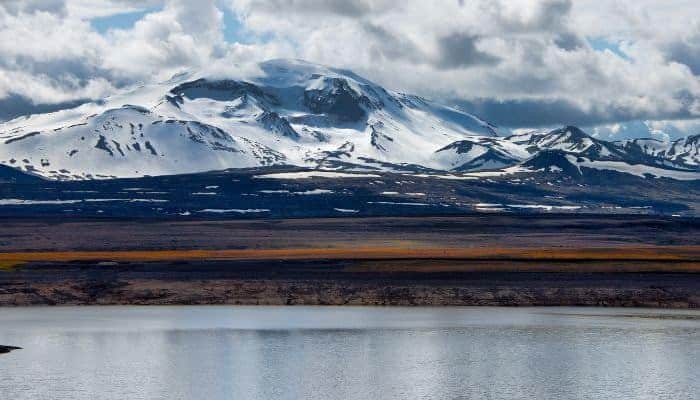
It is famous since the area around the fjord has yielded interesting archaeological finds, traces of 2 paleo-Eskimo cultures named Independence I culture and Independence II culture, after this fjord.
In southern Peary Land, north of the fjord, archaeologists discovered remains of dwellings with elliptical floors constructed by people of the Independence I culture, who made tools from bones and rocks and lived by hunting musk oxen and arctic hares. Evidence shows that the area was inhabited in 2000 BC, while the earliest discoveries date to 2400 BC.
Robert Peary arrived at the fjord’s head in 1892. After this, the Denmark expedition from 1906 to 1908 mapped the whole fjord area, revealing its extent, but the three members of the expedition died and could not return to their base.
4. Hardangerfjord, Norway (179 km)
The 4th longest fjord in the world stretches 179 km or 111 miles from the Atlantic Ocean into the mountainous regions in the interiors of Norway along the Hardangervidda plateau, passing through the Hardanger district.
This fjord is also important for the locals since one of the biggest glaciers in the country, the Folgefonna glacier, lies along this fjord, whose innermost point reaches Odda town.

The Folgefonna glacier, divided into 3 parts, spans 220 km2 and became a protected site as the Folgefonna National Park in 2005.
The fjord’s history goes beyond the Viking era to the time of hunters on the mountains and later when farming was first developed along the fertile region, today called the ‘fruit orchard of Norway’.
The fjord saw a rise in the influx of tourists and travellers after Thomas Cook began weekly cruise departures from London to the fjord in 1875. Gradually, new infrastructure was built to comfort those who came to view the mighty waterfalls, glaciers and valleys surrounding this majestic fjord.
Ideal conditions for fish farming allow a production of over 40,000 tonnes of salmon and rainbow trout, making Hardangerfjord one of the world’s top fish farming regions. Also, water from the fjord is bottled at its source and sold worldwide.
5. Saguenay Fjord, Canada (105 km)
Said to be one of the longest fjords in the world, the Saguenay Fjord is more than 105 kilometres long and is made of 3 basins defined by sills. Once the tide comes, it receives nutrients from the lower estuary carried by the cold oxygen-rich water carrying plankton that sustains life into the fjord’s deepest depths.
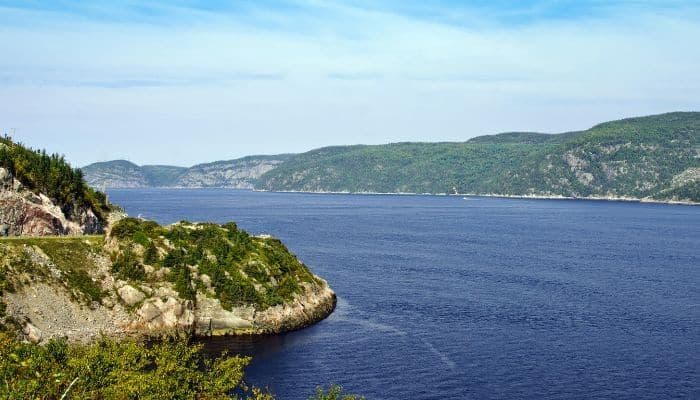
It is a rare fjord since it releases water into an estuary and not the ocean. It makes a deep valley, which is around 275 m, lined with towering cliffs.
Carved out at the edge of the North American continental ice sheet, this fjord is also intracontinental. Tadoussac, which lies at its mouth, was Canada’s first trading post in 1599 since aboriginal people were accustomed to meeting at this place to trade with each other.
The fjord is lined with 300 m high cliffs, reaching the highest point at 460 m at Cap Trinite. The hanging valleys on its side prove that this was indeed carved by a glacier and eventually invaded by the sea. Saguenay narrows towards its mouth; it is 3.5 km broad near Chicoutimi and only 1.3 km when it reaches Tadoussac.
The Saguenay Fjord is a natural resource that needs to be preserved. Many marine species like belugas, fin, minke and blue whales come to feed here. Hence, a marine park and a shoreline conservation park have been established to protect this fjord and its flora and fauna. Also, several cruise ships visit Saguenay so people from across the world can admire the most accessible fjord in North America.
6. Aysen Fjord, Chile (70 km)
This fjord stretches 70 km east from the Moraleda Channel, a body of water that separates the Chonos Archipelago from mainland Chile. It is linked to the coast of the Pacific Ocean through the Darwin Channel.
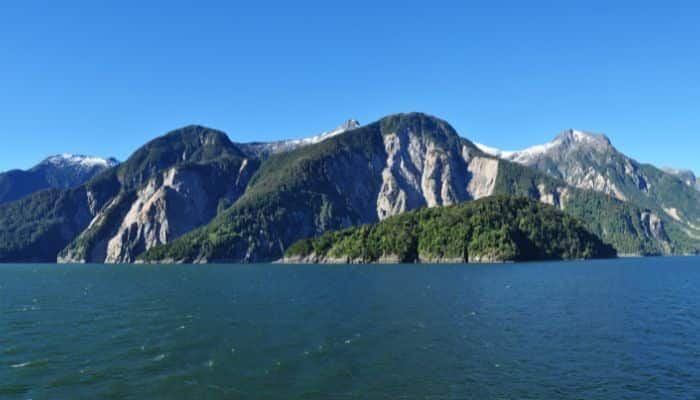
The fjord is replenished by fresh water from the Aysen River that drains into the head of the fjord. Puerto Chacabuco lies by the coast near the fjord’s head, while Puerto Aysen is situated on the Aysen River, just four kilometres near the head of the Aysen fjord.
Aysen Fjord was explored by Enrique Simpson in 1870, and in the 1990s, there were plans to construct an aluminium smelter near the fjord. However, owing to the water pollution as a result of the smelter, the project was dropped.
Today, the region is a famous tourist place with Andes mountains in the south and east, rising from 3,000 to 13,000 feet as rugged blocks separated by fjords and valleys. Glaciers extend into the valleys and some even into the sea. The land at lower elevations is forested mainly with evergreens due to sufficient rain and cool temperatures.
People here grow wheat, barley, berries, lettuce, and potatoes and raise sheep and cattle. Gold, silver, zinc, lead and lumber are also found in the region.
7. Tasermiut Fjord, Greenland (70 km)
This 70 km long fjord in Greenland’s southwestern region is part of the Kujalleq municipality. Near its mouth lies the Nanortalik island. Along this fjord grows the dwarf trees in the Qinngua Valley and Tiningnertoq Valley.
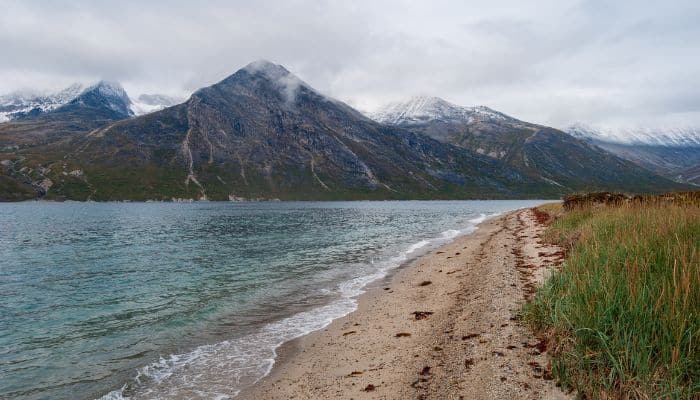
Tasermiut Fjord is oriented in a northeast-southwest direction, and to the southwest, it opens into the Labrador Sea of the North Atlantic Ocean.
This fjord is visited by many kayakers, trekkers, and climbers and is known for its mountains and rocks. Several mountaineering expeditions come to this fjord to conquer its challenging peaks and climb new routes.
It is also a starting point for one of the most difficult treks to Kangikitsoq, Kangerdluk, Herjofsnaes, and Stordalen Havn. This fjord is accessible by boat from Nanortalik, the southernmost major settlement in Greenland.
8. Eyjafjörður, Iceland (60 km)
This beautiful fjord is the longest one in North Iceland, spanning 60 km from its mouth to the city of Akureyri, also known as the ‘northern capital’ of Iceland, visited by 100 cruise ships annually.
It is surrounded by mountains and hills on both sides. Eyjafjarðará, Hörgá and Fnjóská are the main rivers that flow into this fjord.

Two significant valleys along the fjord are Hörgárdalur and Svarfaðardalur. However, the biggest valley is Eyjafjarðardalur, which is 50 km long and has one of the biggest and most fertile agricultural regions in Iceland.
Another popular place is Hrisey island, which is the 2nd biggest island off the Iceland coast and is popularly called ‘The Pearl of Eyjafjorour.
Eyjafjörður has several hydrothermal vents in shallow water, such as the Strytan vent field, designated an Icelandic-protected preserve in 2001. The fjord is also home to humpbacks, blue and minke whales, who come to feed on plankton.
This region is ideal for mountain climbers, nature lovers and hikers, given its mild climate compared to other Icelandic regions and several beautiful old churches, heritage museums, galleries and historic buildings. It is also one of the best places in Iceland to see the Midnight Sun.
9. Lysefjord, Norway (42 km)
Situated in the Ryfylke region in southwestern Norway’s Rogaland County, the 42 km long fjord lies 25 km east of Stavanger city.
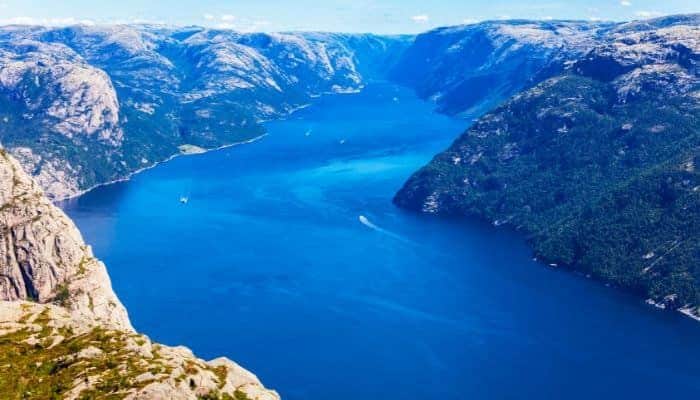
Its name means the light fjord, possibly derived from the light-coloured granite rocks along the sides of the fjord. The fjord is famous for the massive Preikestolen cliff that overlooks the fjord.
At the fjord’s eastern end lies the Lysebotn village, while Forsand and Oanes lie at the fjord’s western end. There are many places to visit and activities to do, such as hikes to viewing points of Kjerag and Preikestolen that can be reached on a day trip from Stavanger.
There are no roads along the fjord, and hence, one can take a cruise. A car ferry takes you to Lysebotn and stops in Flrli, where one can rest and then hike over 4,000 steps up the longest wooden staircase in the world.
10. Doubtful Sound, New Zealand (40 km)
Doubtful Sound is a fjord in the far southwest of New Zealand and is the second most famous tourist attraction in the country after Milford Sound.
It was originally named Doubtful Harbour by Captain Cook in 1770, who didn’t enter the inlet since he was unsure whether it was navigable under sail. It was then renamed Doubtful Sound by whalers and sealers.

It is also called the ‘Sound of Silence; and is the deepest, around 421 m and the second longest (spanning 40 km) of the South Island’s fjords.
It receives high amounts of rainfall with an annual average of 120 to 240 inches, which supports a lush green landscape like that of a dense rainforest.
Doubtful Sound has two layers of water that do not mix, with the top layer being freshwater fed by runoff from the mountains while the layer below it is of salt water from the sea. There is a difference in the refractive index between the 2 layers, making it difficult for light to go deeper; hence, many deep-sea species, like black corals, thrive here in relatively shallow water depths. The fjord also has some splendid waterfalls like Browne Falls and Helena Falls.
You might also like to read-
- Top 10 Fjords in Norway
- 10 Largest Fjords In The World
- 8 Interesting Facts About Cape Route
- 10 Largest Estuaries In The World
- 10 Major Gulfs In North America
Disclaimer :
The information contained in this website is for general information purposes only. While we endeavour to keep the information up to date and correct, we make no representations or warranties of any kind, express or implied, about the completeness, accuracy, reliability, suitability or availability with respect to the website or the information, products, services, or related graphics contained on the website for any purpose. Any reliance you place on such information is therefore strictly at your own risk.
In no event will we be liable for any loss or damage including without limitation, indirect or consequential loss or damage, or any loss or damage whatsoever arising from loss of data or profits arising out of, or in connection with, the use of this website.
Do you have info to share with us ? Suggest a correction
Disclaimer :
The information contained in this website is for general information purposes only. While we endeavour to keep the information up to date and correct, we make no representations or warranties of any kind, express or implied, about the completeness, accuracy, reliability, suitability or availability with respect to the website or the information, products, services, or related graphics contained on the website for any purpose. Any reliance you place on such information is therefore strictly at your own risk.
In no event will we be liable for any loss or damage including without limitation, indirect or consequential loss or damage, or any loss or damage whatsoever arising from loss of data or profits arising out of, or in connection with, the use of this website.

About Author
Zahra is an alumna of Miranda House, University of Delhi. She is an avid writer, possessing immaculate research and editing skills. Author of several academic papers, she has also worked as a freelance writer, producing many technical, creative and marketing pieces. A true aesthete at heart, she loves books a little more than anything else.
Latest Maritime Knowledge Articles You Would Like:
Subscribe To Our Newsletters
By subscribing, you agree to our Privacy Policy and may receive occasional deal communications; you can unsubscribe anytime.















